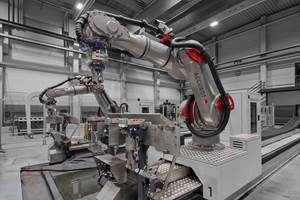DLR rocket flight in ATHEAt program demonstrates CMC nose, movable body flaps
Successful flight tests heat-resistant components and innovative sensor technologies.
Source |
On Oct. 6, the German Aerospace Center (DLR, Braunschweig) launched a 13.5-meter-long research rocket for the program from the Andøya launch site in northern Norway.
The experiment flew for ≈4 minutes, including 2 minutes of high-speed flight with the peak speed exceeding Mach 9, exposing the vehicle to gas temperatures exceeding 2000°C and extreme aerothermal loads on its structures and materials — similar to those encountered by spacecraft re-entering Earth’s atmosphere. During the flight, the research rocket reached a maximum altitude of more than 30 kilometers.
The shimmering gray nose cone of the rocket was made largely from a fiber- reinforced ceramic matrix composite (CMC) manufactured entirely at DLR using specially developed in-house processes.
This high-performance material not only withstands very high temperatures but is also strong and relatively lightweight. The scientific payload onboard the ATHEAt flight included two cooling experiments which researchers used to investigate how the extreme high temperatures at the nose of the rocket can be managed through active cooling.
The ATHEAt flight experiment’s front body also included four movable flaps made of DLR’s CMC which were successfully deployed during the flight and experienced very high temperatures. In the future, such flaps could be used to make space transportation vehicles more controllable.
The CMC nose cone and deployable body flaps on the ATHEAt first rocket. Source | . For more details, see .
To achieve the highest possible temperatures, the research rocket flew along a specially planned, shallower trajectory, enabling it to fly at high Mach numbers for an extended period at relatively low altitudes. A newly developed DLR sensor network provided essential data to determine the precise moment of ignition for the second stage. This “sensor cube” uses a defined starting position and measures the acceleration and rotation rates in flight to calculate the position of the rocket in space. At the end of its flight, it splashed down safely in a designated and secure area of the Norwegian Sea.
Successful first flight
“With the ATHEAt flight experiment, we have succeeded in flying at high Mach numbers for much longer than in our previous projects,” says Ali Gülhan, ATHEAt project manager and head of the Supersonic and Hypersonic Technologies Department at the DLR Institute of Aerodynamics and Flow Technology. “We have now reached a new milestone and collected data for further R&D.”
This data harvest was made possible by the more than 300 sensors installed by the DLR team into the flight experiment. Also on board were miniaturized, noncontact sensors such as infrared cameras, laser scanners and radiation thermometers. A modular data acquisition system developed by DLR recorded the measurements and transmitted the processed data by radio to ground stations below.
“The conditions simulated in the ATHEAt flight experiment are comparable to those that thermal protection systems on future reusable space transport systems will have to reliably withstand during reentry into Earth’s atmosphere,” explains Gülhan. The reentry phase, with its extreme aerodynamic and aerothermodynamic conditions, is also a crucial point of development for the space industry. “With projects like ATHEAt, we are specifically working on closing this global technology gap.”
DLR combines flight experiments like ATHEAt and its predecessor projects, supported and continuously refined with sophisticated simulations, design processes and component testing on the ground.
ATHEAt program
Initiated in January 2022, the ATHEAt program seeks to test key technologies aimed to make future reusable space vehicles more reliable and cost-efficient, with an emphasis on reentry performance. The program is also developing a hybrid rocket booster for use as a future sounding rocket upper stage.
The technologies developed are being tested in ground tests and two space flights. This first flight was structured to test materials, cooling techniques, miniaturized nonintrusive sensors and the aerodynamic properties of the two-stage sounding rocket. The first stage was powered by a Red Kite booster developed by DLR in partnership with Bayern-Chemie, while the second stage was powered by a Canadian-built Black Brant Mark 4 booster.
A second launch, scheduled for 2026 from Esrange Space Center in Sweden, will mark the inaugural flight of the Alduina hybrid rocket booster. Powered by hydrogen peroxide and hydroxyl-terminated polybutadiene (HTPB), the booster is designed to enable throttleability and reignition while maintaining low system complexity.
Related Content
Automated robotic NDT enhances capabilities for composites
Kineco Kaman Composites India uses a bespoke Fill Accubot ultrasonic testing system to boost inspection efficiency and productivity.
Read MoreComposites end markets: New space (2025)
Composite materials — with their unmatched strength-to-weight ratio, durability in extreme environments and design versatility — are at the heart of innovations in satellites, propulsion systems and lunar exploration vehicles, propelling the space economy toward a $1.8 trillion future.
Read MoreNear-zero erosion ultra-high temperature CMC
K3RX commercializes UHTCMC for a wide range of markets, demonstrating performance in prototypes, assemblies and advancing manufacturing to reduce cost.
Read MoreLow-cost, efficient CFRP anisogrid lattice structures
CIRA uses patented parallel winding, dry fiber, silicone tooling and resin infusion to cut labor for lightweight, heavily loaded space applications.
Read MoreRead Next
CIRA qualifies CMC structures for the reusable Space Rider
Italian team designs, builds and tests multiple large, complex thermal protection system structures made from patented ISiComp C/C-SiC ceramic matrix composites.
Read MoreDLR-SY exhibits full-scale CFRP liquid hydrogen tank test item for zero-emission aviation
The German Aerospace Center Institute for Lightweight System Construction exhibits 1.9-meter autoclave infusion composite structure as part of LUFO UpLift project aiming for LH2 as part of short-haul aircraft propulsion by 2040.
Read MoreNext-gen fan blades: Hybrid twin RTM, printed sensors, laser shock disassembly
MORPHO project demonstrates blade with 20% faster RTM cure cycle, uses AI-based monitoring for improved maintenance/life cycle management and proves laser shock disassembly for recycling.
Read More












